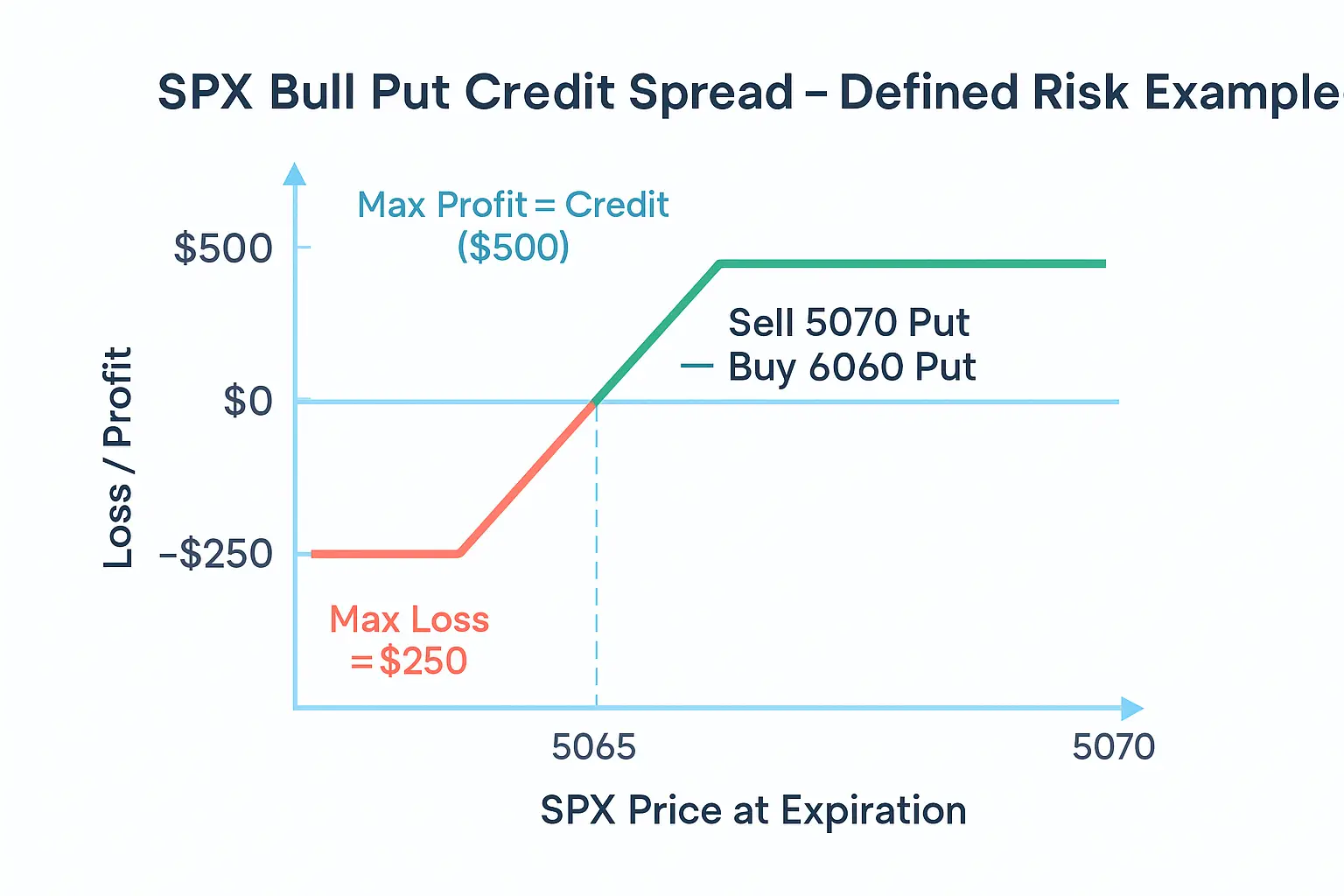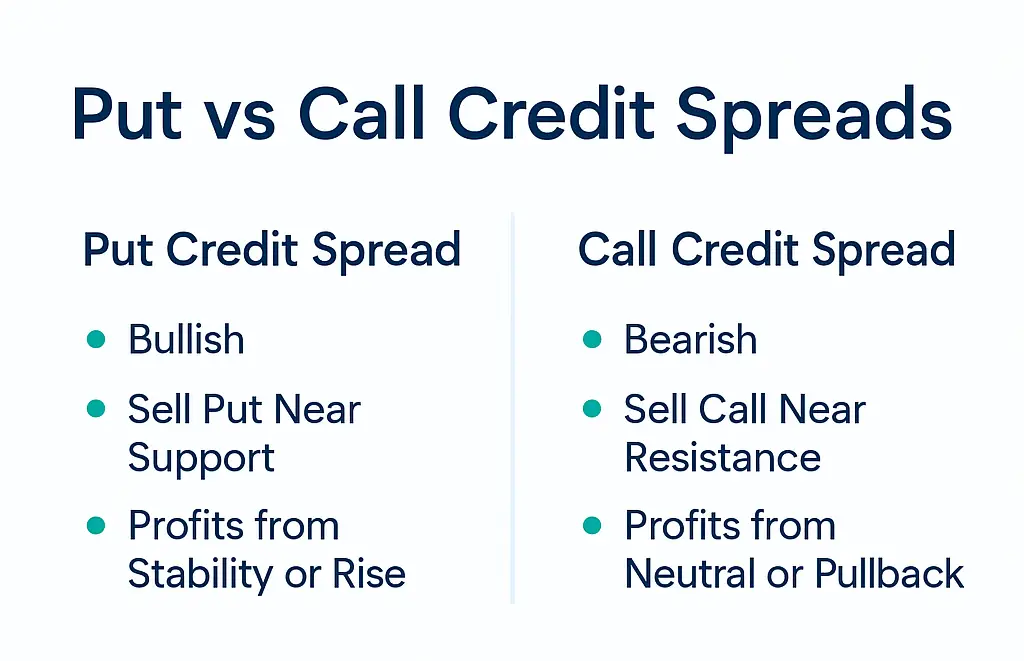If you’ve learned the basics of what a credit spread is, the next step is to see how it works in the real world. Here, I’ll walk you through two realistic SPX examples — a bull put spread and a bear call spread — so you can see how I evaluate risk, reward, and probability before placing a trade.
Credit spreads are one of the most powerful defined-risk strategies available to retail traders. You know your maximum loss, your maximum gain, and your breakeven from the start. The key is structuring them correctly based on your market bias and volatility conditions.
If you’re brand new to spreads, start with the basics:
What Is a Credit Spread?
or check my step-by-step guide
Credit Spread Strategy: When and How to Use It.
Trader’s insight: I trade SPX credit spreads weekly because they offer consistency and predictability. When you understand the math, you don’t need to guess the market — you just need to manage probability.
Example 1: SPX Bull Put Credit Spread (Mildly Bullish)
A bull put spread is a bullish credit spread where you sell a put option closer to the current price and buy another put further out of the money for protection. You earn a credit upfront and profit if SPX stays above your short strike at expiration.
Trade Setup
- Underlying: SPX
- Current Price: 5000
- Sell: 5070 put
- Buy: 5060 put
- Width: 10 points
- Credit Received: $5.00
- Days to Expiration: 30 (typical for Monthly Trend setups)
Trade Metrics
- Max Profit: $5.00 × 100 = $500 (credit received)
- Max Loss: (10 − 5) × 100 = $500
- Breakeven: 5070 − 5 = 5065
- Probability of Profit: around 60–70%
This is my go-to setup when I expect SPX to stay above support or drift higher. With a 5-point credit on a 10-point spread, the risk-to-reward ratio is roughly 1:1. This is a probability-based strategy. Most months, SPX won’t break below your short strike.
Tip: I usually close my bull put spreads at 50% of the max loss. That improves my risk-to-reward ratio to 1:2 while having a 60-70% win rate.

Example 2: SPX Bear Call Credit Spread (Mildly Bearish)
A bear call spread is the mirror image of a bull put spread. It’s a bearish credit spread where you sell a call near resistance and buy another call further out of the money to define risk. You profit if SPX stays below your short call by expiration.
Trade Setup
- Underlying: SPX
- Current Price: 5000
- Sell: 4960 call
- Buy: 4970 call
- Width: 10 points
- Credit Received: $5.00
- Days to Expiration: 30
Trade Metrics
- Max Profit: $5.00 × 100 = $500 (credit received)
- Max Loss: (10 − 5.00) × 100 = $500
- Breakeven: 4960 + 5.00 = 4965
- Probability of Profit: about 60–70%
This trade benefits from time decay and resistance levels holding. If SPX consolidates or drifts lower, the short call decays quickly, allowing you to buy it back cheaper. The long call protects you if SPX unexpectedly rallies.
Note: I avoid holding bear call spreads through major news events (like CPI or FOMC). Volatility can spike, widening spreads and distorting P&L.

Credit Spread Calculator: Understanding Risk and Reward
Every credit spread can be broken down into three key components: credit received, spread width, and breakeven point. Understanding how these elements interact helps you estimate risk and profit potential before placing a trade.
Formulas:
- Max Profit: Credit received × 100
- Max Loss: (Spread width − credit) × 100
- Breakeven: Short strike ± credit (minus for puts, plus for calls)
Let’s use the SPX bull put spread from earlier as an example:
- Sell: 5070 put
- Buy: 5060 put
- Credit: $5.00
Max Profit = $500, Max Loss = $500, Breakeven = 5065.
If SPX expires above 5070, you keep the full credit. If it falls below 5060, you lose the maximum.
That’s why we call this a defined-risk trade — there are no surprises at expiration.
Pro tip: Before entering a trade, always check your broker’s margin requirement.
Many brokers will reserve the full spread width (minus the credit), even though your loss is capped.
Common Mistakes Traders Make With Credit Spreads
Even though credit spreads are safer than naked options, traders still make predictable mistakes that hurt results. These errors usually come from misunderstanding volatility, sizing, or timing.
- 1. Selling too far out of the money: lower credit means higher risk if being wrong.
- 2. Ignoring volatility shifts: selling spreads during low IV can offer little reward for the risk taken.
- 3. Holding to expiration: trying to squeeze out the last few dollars increases gamma risk dramatically in the last 7 days before expiration.
- 4. Oversizing trades: even defined risk can hurt if you over-leverage your account.
- 5. Trading during major news events: CPI, FOMC, or NFP can move SPX 50+ points overnight — beyond your strikes.
Rule of thumb: trade smaller, close earlier, and avoid entering spreads through volatility events.
The goal is consistency — not perfection.
FAQs About Credit Spread Examples
1. How much can you make with a credit spread?
Your profit is limited to the credit received. For example, a $5.00 credit on a 10-point spread means your max gain is $500. The goal is not to hit home runs, but to collect repeatable profits over time.
2. What happens if the stock moves against your credit spread?
Your maximum loss is capped. If SPX closes below your short put (or above your short call), both legs are exercised, and you take the full defined loss. Proper sizing keeps this from damaging your account.
3. Are credit spreads safe for beginners?
They’re one of the safest strategies for beginners because you know exactly how much you can lose or make. Just keep risk small and avoid holding through major volatility events.
4. When is the best time to trade credit spreads?
Sell them when implied volatility is elevated and the market looks stable. Avoid periods right before earnings or high-impact news, when spreads widen and prices move unpredictably.
5. Can credit spreads be automated?
Yes. Many traders, including me, automate SPX credit spreads for consistency. Systems can place and manage trades based on predefined rules, removing emotion and execution errors.
Conclusion: Turning Credit Spread Theory Into Practice
Credit spreads are one of the most efficient ways to trade defined risk. They allow you to generate consistent income without guessing direction, as long as you respect volatility and position sizing.
Whether you use a bull put spread or a bear call spread, the key is matching your setup to the market. Sell puts when the market looks stable or bullish, and sell calls when price stalls or reverses near resistance. Each trade has a purpose — it’s never random.
After 20 years of trading SPX options, I’ve learned that predictable income comes from structure, not prediction. Credit spreads deliver exactly that — structure, control, and consistency.
To dive deeper into how I automate these setups weekly on SPX and SPY, explore the service below:
Automate Your Credit Spread Trading
Our Bull Put Credit Spread Signals system executes SPX trades automatically, following the same defined-risk rules outlined in this guide. Consistency — without emotion.

